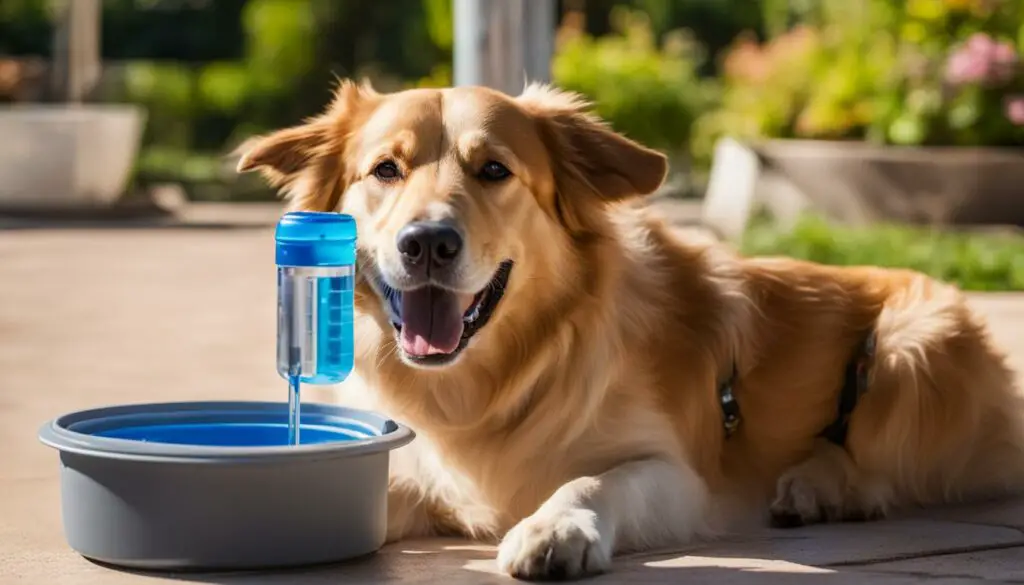As a dog owner, it’s important to understand how hot weather can affect our furry friends. Dogs have a higher body temperature than humans, which makes them more susceptible to heat-related complications. In fact, heat stroke can occur in dogs at temperatures as low as 106℉, with a mortality rate of nearly 50%. Even a small increase in their internal body temperature can lead to health issues and overheating. This is why it’s crucial to take extra precautions during hot weather, especially in the summer months.
So, how hot is too hot for dogs? In this guide, I will provide you with essential information on determining the temperature limits for dogs and offer practical tips for preventing heat stroke and ensuring your pet’s safety.
Key Takeaways:
- Dogs are more sensitive to heat than humans due to their higher body temperature.
- Heat stroke can occur in dogs at temperatures as low as 106℉, with a high mortality rate.
- Dogs can experience health complications and overheating with just a four-degree internal temperature change.
- Preventing dogs from overheating is crucial, especially during the summer months.
- This guide will provide information on how hot is too hot for dogs and offer tips for heat stroke prevention and summer safety.
How hot is too hot for dogs to walk?
When it comes to taking your dog for a walk during hot weather, it’s important to consider both the temperature and humidity levels. Dogs primarily cool off by panting, but high humidity can hinder their ability to evaporate moisture from their lungs, leading to an increase in body temperature. So, how hot is too hot for dogs to walk?
If the temperature is too hot or the humidity levels are high, it’s best to keep your furry friend indoors. To ensure their safety and prevent overheating, try scheduling walks early in the morning or late in the evening when temperatures are cooler. This way, you can avoid exposing your dog to the peak temperature extremes that can be detrimental to their well-being.
Protecting your dog’s paws from hot pavement
Another important consideration is the temperature of the pavement. On a sunny day, the asphalt can get scorching hot, which can cause burns on your dog’s delicate paw pads. To assess if the pavement is too hot for your pup, place the back of your hand on it. If you can’t comfortably leave it there for five seconds, it’s too hot for your dog to walk on.
To protect your dog’s paws, opt for walking them on grass or dirt instead of hot pavement. This will help prevent burns and discomfort. Additionally, try to avoid walking your dog during the hottest part of the day when the pavement is more likely to be at its hottest temperature.
Stay aware and keep your dog safe
Remember, as a pet parent, it’s your responsibility to keep your dog safe and comfortable during hot weather. Pay attention to both the temperature and humidity levels, and adjust your walking routine accordingly. By taking these precautions, you can ensure that your furry companion stays cool and happy throughout the summer months.

How hot is too hot for dogs’ paws?
Hot pavement can be a significant concern for dogs during the summer months. The delicate paw pads of dogs can easily be burned by excessively hot pavement, causing pain and discomfort. It’s important for pet parents to be aware of the temperature of the ground before taking their dogs for a walk. To determine if the pavement is too hot for your dog, simply place the back of your hand on the surface for five seconds. If you find it uncomfortable to leave your hand there for that long, it’s too hot for your dog to walk on.
On a sunny day with a temperature of 77℉, the asphalt can reach temperatures as high as 127℉. This can cause significant damage to your dog’s paws within a matter of minutes. It’s essential to take precautions to protect their sensitive paw pads. One way to do this is by scheduling walks during cooler parts of the day, such as early morning or late evening, when the ground is not as hot. Additionally, walking your dog on grass or dirt surfaces can help prevent burns and discomfort.
| Temperature (℉) | Pavement temperature (℉) |
|---|---|
| 77 | 127 |
| 85 | 143 |
| 95 | 153 |
When walking your dog, always be observant of their behavior. If you notice them lifting their paws, walking slowly, or trying to avoid stepping on certain surfaces, it could be a sign that the pavement is too hot for them to handle. It’s better to err on the side of caution and choose a different route or wait for the ground to cool down before taking your dog out for a walk.
How hot is too hot for dogs to wait in a car?
Leaving a dog in a car, even with the windows cracked, can be deadly. The temperature inside a car can reach dangerous levels within minutes, even on relatively mild days. It is never worth the risk to leave a dog in a car, and many states have laws against leaving dogs alone in cars. It is safer to leave dogs at home or find alternative arrangements when running errands or traveling.
I always make sure to leave my dog at home or find a pet-friendly location when I need to run errands. It’s just not worth taking any chances with their safety and well-being. Remember, a quick stop can turn into a dangerous situation for a dog left in a hot car.
According to the American Veterinary Medical Association, the temperature inside a parked car can rise rapidly, reaching up to 20 degrees higher than the outside temperature within just 10 minutes. This can put your dog at risk of heatstroke and even death. Dogs are unable to regulate their body temperature as efficiently as humans, and their furry coats can make them even more susceptible to overheating.
If you find yourself in a situation where you must be in a car with your dog on a hot day, make sure to take precautions. Keep the air conditioning on, provide constant access to water, and make frequent stops to let your dog out of the car and cool down. Never leave your dog unattended, even for a few minutes.
| Temperature Outside | Temperature Inside Car | Time Elapsed |
|---|---|---|
| 70℉ | 89℉ | 10 minutes |
| 75℉ | 94℉ | 10 minutes |
| 80℉ | 99℉ | 10 minutes |
| 85℉ | 104℉ | 10 minutes |
Remember, it’s always better to be safe than sorry when it comes to your furry friend’s safety. Avoid leaving your dog in a car and find alternatives to keep them cool and comfortable during hot weather.
How hot is too hot for dogs to be outside?
When it comes to determining how hot is too hot for dogs to be outside, it’s important to consider multiple factors. While some dogs may be fine in temperatures up to 90 degrees Fahrenheit with access to shade and water, certain dogs, such as older, overweight, or brachycephalic breeds, are more vulnerable to heat and should avoid being outdoors in high temperatures. It’s essential to consider the individual dog’s risk factors and provide appropriate measures to keep them cool and safe.
H3: Dogs at higher risk
Brachycephalic breeds, or dogs with pushed-in noses, have limited ability to breathe and pant efficiently, making them at higher risk of overheating. Additionally, dogs that are overweight, older in age, or have underlying health conditions may struggle to regulate their body temperature effectively. These dogs may require extra precautions and should be monitored closely for signs of overheating and heatstroke.
| Factors to consider: | Dogs at higher risk: |
|---|---|
| Brachycephalic breeds | Pugs, Bulldogs, Boxers |
| Overweight dogs | Obese or overweight dogs |
| Older dogs | Elderly dogs |
| Dogs with underlying health conditions | Dogs with heart or respiratory issues |
“While some dogs may tolerate hot temperatures better than others, it’s crucial to remember that every dog is different. Individual factors such as breed, weight, and age play a significant role in determining a dog’s ability to handle the heat. It’s always better to err on the side of caution and provide extra care and attention to dogs that may be more susceptible to heat-related complications.”
– Dr. Amanda Thompson, Veterinarian
To ensure the safety of your dog during hot weather, it’s recommended to limit their time outside during peak temperature hours, provide plenty of fresh water and shade, and monitor their behavior closely for signs of overheating. Taking these precautions can help keep your furry friend cool and comfortable throughout the summer months.
Risk Factors for Dogs in High Temperatures
When it comes to hot weather, dogs can be particularly vulnerable to heat-related complications. Certain factors can increase a dog’s susceptibility to overheating and heatstroke. It’s important for pet parents to be aware of these risk factors and take appropriate measures to keep their furry friends safe and cool.
Factors Influencing Heat Susceptibility
Several factors can influence a dog’s ability to tolerate high temperatures. Brachycephalic breeds, such as Bulldogs and Pugs, are at higher risk due to their limited ability to breathe and pant efficiently. Dogs with heavy or wiry fur coats may also have a harder time dissipating heat. Additionally, dogs that are overweight, older, or have underlying health conditions are more prone to heat exhaustion.
Signs of Heatstroke in Dogs
It’s crucial for pet parents to recognize the signs of heatstroke in dogs. Heavy panting, excessive drooling, rapid heartbeat, and difficulty breathing are common symptoms. A dog’s tongue or gums may appear bright red, and they may exhibit weakness, confusion, or even seizures. If you notice any of these signs, it’s important to seek immediate veterinary assistance.

Preventing Heatstroke in Dogs
Prevention is key when it comes to keeping dogs safe in hot weather. Provide plenty of shade and fresh water for your furry friend to stay cool. Avoid leaving dogs in cars, as the temperature can quickly become life-threatening. Monitor the pavement temperature before going on walks to prevent burns on your dog’s paws. Additionally, avoid strenuous exercise during the hottest parts of the day and provide a cool and well-ventilated environment for your pet.
| Risk Factors for Dogs in High Temperatures | Signs of Heatstroke in Dogs | Preventing Heatstroke in Dogs |
|---|---|---|
| – Brachycephalic breeds – Dogs with heavy or wiry fur coats – Overweight dogs – Older dogs – Dogs with underlying health conditions |
– Heavy panting – Excessive drooling – Rapid heartbeat – Difficulty breathing – Bright red tongue or gums – Weakness or confusion |
– Provide shade and fresh water – Avoid leaving dogs in cars – Monitor pavement temperature – Avoid strenuous exercise during hot parts of the day – Provide a cool and well-ventilated environment |
How to Keep Dogs Cool in Summer: Essential Tips for Dog Summer Safety
When the temperature rises during the summer months, it’s crucial to take extra precautions to keep our furry friends cool and safe. As a pet parent, I understand the importance of preventing heatstroke and providing a comfortable environment for my dog. Here are some essential tips for keeping dogs cool in summer:
- Provide constant access to shade and water: It’s essential to ensure that your dog has a cool and shady spot to retreat to when the sun is blazing. Make sure there is always fresh and cool water available for your dog to stay hydrated.
- Use cooling mats or wet towels: Cooling mats or wet towels can provide relief from the heat. Place a cooling mat in your dog’s favorite resting spot or wet a towel and drape it over them to help lower their body temperature.
- Avoid leaving dogs alone in cars: Leaving a dog unattended in a car, even for a short period, can be extremely dangerous. The temperature inside a car can rise rapidly, even with the windows cracked. It’s always best to leave your dog at home or find alternative arrangements when running errands.
- Trim or thin out the hair: If your dog has a heavy coat, consider trimming or thinning out their hair to help them stay cool. Consult with a professional groomer to ensure you’re using the appropriate techniques and tools.
Remember, the key is to be proactive in preventing overheating and heatstroke in dogs. By following these tips and keeping a close eye on your furry friend, you can help ensure a safe and enjoyable summer for both of you.
| Signs of Heatstroke in Dogs | Prevention Tips |
|---|---|
| Heavy panting | Provide access to shade and water |
| Excessive drooling | Use cooling mats or wet towels |
| Rapid or heavy breathing | Avoid leaving dogs in cars |
| Bright red tongue or gums | Trim or thin out the hair of dogs with heavy coats |
“Keeping our dogs cool in summer is not just a matter of comfort, but a vital aspect of their well-being. By taking proactive measures, we can ensure that our beloved companions stay safe and healthy during the hot months.”
Creating a Cool Haven
One of the most effective ways to keep dogs cool in summer is to create a cool haven for them. Whether it’s setting up a shaded area in your backyard or using a portable shade structure, providing a designated area for your dog to escape the heat is essential. Consider using a cooling mat or bed in this area to provide extra comfort.
Additionally, you can create a cooling station by placing ice packs or frozen water bottles wrapped in a towel near your dog’s resting spot. This will help lower their body temperature when they lie down next to it. Always monitor your dog to ensure they are not chewing on or ingesting the ice packs or bottles.

By implementing these strategies and remaining vigilant about your dog’s well-being during hot weather, you can ensure that your canine companion stays cool, comfortable, and safe all summer long.
How to Tell if a Dog is Overheated
During hot summer months, it’s crucial to monitor our furry friends for signs of overheating and heatstroke. Dogs don’t have the same cooling mechanisms as humans, making them more prone to heat-related complications. By knowing how to identify the signs of an overheated dog, we can take immediate action to prevent further harm. Here are some key indicators to watch for:
Signs of Heatstroke in Dogs:
- Rapid or heavy panting
- Excessive drooling
- Quickened heart rate
- Difficulty breathing
- Bright red tongue or gums
If you notice any of these symptoms in your dog, it’s crucial to act quickly. Move your dog to a cool, shaded area immediately and offer fresh water. You can also use a wet towel or spray them with cool water to help bring down their body temperature. It’s important to contact your veterinarian for further guidance and possible emergency care.
Remember, prevention is key when it comes to heatstroke in dogs. Avoid leaving your dog in a hot car, and provide plenty of shade and fresh water at all times. Limit outdoor activities during peak temperatures, and consider using cooling mats or other products designed to keep dogs cool. By keeping a close eye on our canine companions and taking necessary precautions, we can ensure their safety and well-being during hot summer days.
Recapping Key Takeaways
As we conclude our discussion on how hot is too hot for dogs, it’s important to summarize the key takeaways to ensure the safety and well-being of our furry friends during hot weather. By taking the following precautions, we can prevent dog heat exhaustion and reduce the risk of heatstroke:
- Adjust outdoor activities: Schedule walks and exercise during the cooler parts of the day, such as early mornings or late evenings, to avoid peak temperature extremes.
- Monitor paw safety: Before going for a walk, check the pavement temperature by placing the back of your hand on the ground. If it’s too hot for you to leave it there comfortably for five seconds, it’s too hot for your dog.
- Avoid leaving dogs in cars: Even with windows cracked, the temperature inside a car can rise dangerously within minutes. It’s safer to leave dogs at home or find alternative arrangements.
- Provide shade and water: Ensure that dogs have access to cool, shaded areas and plenty of fresh water to stay hydrated.
- Recognize signs of overheating: Be vigilant for symptoms such as heavy drooling, excessive thirst, rapid panting, difficulty breathing, and bright red tongue or gums. Seek veterinary assistance if these signs are observed.
By following these guidelines, we can keep our dogs cool and safe during hot weather, preventing the risk of heatstroke and ensuring a happy and healthy summer for our beloved pets.

| Signs of Overheating | Prevention Methods |
|---|---|
|
|
Understanding the Origins of “Dog Days of Summer”
Have you ever wondered where the phrase “dog days of summer” comes from? It’s not actually about the temperature getting hotter and more sultry. The phrase originated from the belief that the brightest star in the constellation Canis Major, Sirius, influenced the hot weather. The ancient Greeks and Romans believed that Sirius, also known as the Dog Star, rose just before the sun during the summer months, and they associated its appearance with the heat of the season. Dogs themselves don’t have a direct connection to this phrase, but they do have ways of letting us know when they’re feeling the heat.
Excessive panting is one of the primary ways dogs cool themselves down. When it’s hot, dogs rely on panting to evaporate moisture from their tongues and respiratory tract, which helps lower their body temperature. Panting is less effective in high humidity levels because the moisture in the air hampers evaporation. This is why dogs may struggle more in humid climates compared to dry ones. So, while the dog days of summer might not be directly related to our furry friends, they do remind us of the importance of keeping our dogs cool and comfortable during the hottest months of the year.
“The ancient Greeks and Romans believed that Sirius, also known as the Dog Star, rose just before the sun during the summer months, and they associated its appearance with the heat of the season.”
As a dog owner, it’s essential to be aware of the signs of overheating in dogs. Heavy panting, excessive drooling, rapid heart rate, and bright red tongue or gums can all indicate that a dog is overheating. If you notice these symptoms, it’s important to take immediate action to cool your dog down. Provide shade, water, and wet towels to help lower their body temperature. If the symptoms worsen or persist, it’s crucial to seek veterinary assistance as heatstroke can be life-threatening for dogs.
In conclusion, while the dog days of summer may not directly involve our canine companions, it’s a reminder to pay attention to their well-being during hot weather. By understanding the origins of the phrase and recognizing the signs of overheating, we can ensure that our furry friends stay cool, comfortable, and safe throughout the summer months.

Factors influencing how hot is too hot for dogs
When it comes to determining how hot is too hot for dogs, several factors come into play. These factors can influence a dog’s tolerance for heat and their risk of heat-related complications. Understanding these factors is crucial for ensuring the safety and well-being of our furry friends during hot weather.
One of the primary factors is breed. Different breeds have different levels of heat tolerance. For example, brachycephalic breeds, such as Bulldogs and Pugs, are more susceptible to heat exhaustion due to their short snouts and limited ability to pant efficiently. Additionally, dogs with heavy or wiry fur coats may have a harder time dissipating heat, making them more vulnerable to overheating.
The size of the dog also plays a role. Larger dogs tend to generate more body heat and may have a harder time cooling down compared to smaller breeds. Similarly, the dog’s activity level can impact their heat tolerance. Dogs that are more active and engaged in vigorous exercise may require more frequent breaks and measures to cool down and prevent overheating.
Environmental conditions are another important factor. High temperatures and humidity levels can hinder a dog’s ability to cool down through panting. Dogs are less effective at evaporating moisture from their lungs in humid conditions, leading to a spike in body temperature. It is important to consider both the temperature and humidity level when determining how hot is too hot for your dog.
Factors Influencing How Hot is Too Hot for Dogs:
| Factor | Influence on Heat Tolerance |
|---|---|
| Breed | Different breeds have varying levels of heat tolerance. Brachycephalic breeds and those with heavy fur coats are at higher risk. |
| Size | Larger dogs may have a harder time cooling down compared to smaller breeds. |
| Activity Level | More active dogs may require more frequent breaks and cooling measures. |
| Environmental Conditions | High temperatures and humidity can hinder a dog’s ability to cool down through panting. |
By taking into account these factors and monitoring your dog’s behavior and well-being in hot weather, you can ensure their safety and reduce the risk of heat-related complications. It is essential to provide access to shade, fresh water, and regular breaks in a cool environment. If you suspect your dog may be overheating or experiencing heat exhaustion, it is important to seek veterinary assistance immediately.

Remember, prevention is key when it comes to keeping our canine companions safe during hot weather. By understanding the factors that influence how hot is too hot for dogs and taking appropriate precautions, we can ensure a happy and healthy summer for our beloved pets.
Precautions for Dogs in Hot Weather
When it comes to hot weather safety, it is important to take precautions to ensure the well-being of our four-legged friends. Here are some key tips to keep in mind:
1. Plan outdoor activities wisely:
Avoid going for walks or engaging in strenuous activities during the hottest parts of the day. Instead, opt for early morning or late evening outings when temperatures are cooler. This will help prevent your dog from overheating and minimize the risk of heatstroke.
2. Check the surface temperature:
Before taking your dog for a walk, test the pavement or ground with the back of your hand. If it feels too hot for you to comfortably leave your hand on it, it’s too hot for your dog’s delicate paws. Opt for grassy areas or shaded paths to protect your dog from burns or discomfort.
3. Provide access to shade and water:
Ensure that your dog has access to shaded areas where they can take refuge from the sun’s heat. Additionally, always have fresh, cool water available for your dog to drink. It is essential to keep them hydrated, as dehydration can worsen the effects of heat on their bodies.
4. Recognize signs of overheating:
Be vigilant for symptoms of heat exhaustion or heatstroke in your dog. These may include heavy panting, excessive drooling, rapid breathing, weakness, vomiting, and collapse. If you notice any of these signs, seek immediate veterinary attention to prevent further complications.

By following these precautions, you can help ensure that your furry companion stays safe and comfortable during hot weather. Remember, prevention is key when it comes to protecting your dog from heat-related issues. Stay aware of the temperature, provide necessary care, and enjoy a worry-free summer with your canine companion.
Unique Safety Concerns for Dogs in Hot Weather
When it comes to ensuring the safety of our beloved dogs in hot weather, there are some unique considerations to keep in mind. Here are some important safety concerns that every dog owner should be aware of:
1. Swimming Safety
Swimming can be a great way for dogs to cool down, but not all dogs are natural swimmers. It is crucial to never leave your dog unattended around water, whether it’s a pool, lake, or any other body of water. Not all dogs instinctively know how to swim, and even those that do may tire easily or struggle in rough water. Always supervise your dog when they are near water and consider using a doggie life jacket for added safety.
2. Pool Chemicals
If you have a swimming pool, it’s important to be mindful of the chemicals used to keep the water clean. Chlorine tablets, for example, can be toxic to dogs if ingested. Make sure to keep all pool chemicals stored safely out of reach of your furry friend. Additionally, rinse your dog off with fresh water after they’ve been in the pool to remove any chemicals that may be on their fur or skin.
3. Special Considerations for Senior Dogs
Elderly dogs and those with pre-existing health conditions may be more susceptible to the heat. They may have reduced tolerance for high temperatures and may struggle to regulate their body temperature. It’s important to provide them with extra care and attention during hot weather. Keep them indoors in a cool and comfortable environment, make sure they have access to fresh water at all times, and avoid strenuous activities that could overexert them.
| Safety Concerns | Precautions |
|---|---|
| Swimming Safety | Never leave your dog unattended around water, consider using a doggie life jacket. |
| Pool Chemicals | Keep pool chemicals stored safely out of reach of your dog, rinse them off after swimming. |
| Special Considerations for Senior Dogs | Provide extra care and attention, keep them in a cool and comfortable environment, avoid overexertion. |
By being aware of these unique safety concerns and taking appropriate precautions, you can ensure that your furry friend stays safe and healthy during the hot summer months.
Conclusion
In conclusion, understanding how hot is too hot for dogs is essential for their safety and well-being during hot weather. By taking appropriate precautions and following dog summer safety guidelines, we can prevent heatstroke and keep our furry friends cool and comfortable.
It is important to consider factors such as temperature, humidity, and individual risk factors when determining if it is safe for dogs to be outside. Providing shade and constant access to fresh water is crucial, as well as scheduling walks during cooler parts of the day to avoid peak temperature extremes.
Monitoring dogs’ paws on hot pavement is also important, as it can cause burns and discomfort. Additionally, never leave dogs unattended in cars, as the temperature inside can rise dangerously within minutes. Signs of heatstroke should be recognized, and immediate veterinary attention should be sought if necessary.
By prioritizing dog summer safety and taking the necessary precautions, we can ensure that our dogs stay healthy, happy, and cool during hot weather. Remember, our furry friends rely on us to keep them safe, so let’s make their well-being a top priority!
FAQ
How hot is too hot for dogs to walk?
Dogs should not be walked in extreme heat or high humidity. It is best to schedule walks for early morning or late evening when temperatures are cooler.
How hot is too hot for dogs’ paws?
Dogs’ paw pads can be burned by hot pavement. If the ground is too hot for you to comfortably leave your hand on, it is too hot for your dog to walk on.
How hot is too hot for dogs to wait in a car?
Leaving a dog in a car, even with the windows cracked, can be deadly. The temperature inside a car can reach dangerous levels within minutes, even on mild days.
How hot is too hot for dogs to be outside?
If you are uncomfortable outside, it is likely too hot for your dog to be outside for an extended period of time. Certain dogs, such as older or overweight breeds, are more vulnerable to heat and should avoid being outdoors in high temperatures.
What are the risk factors for dogs in high temperatures?
Certain breeds, obesity, older age, and underlying health conditions can increase a dog’s susceptibility to heat-related complications. These dogs may require extra precautions and should be monitored closely for signs of overheating and heatstroke.
How can I keep my dog cool in hot weather?
Providing constant access to shade and water, using cooling mats or wet towels, keeping the air conditioning on indoors, and limiting exposure to the sun and hot temperatures are essential for keeping dogs cool in hot weather.
How can I tell if my dog is overheated?
Signs of overheating in dogs include heavy drooling, excessive thirst, rapid panting, difficulty breathing, and bright red tongue or gums. Severe cases can lead to confusion, weakness, seizures, or organ failure. Seek veterinary assistance if your dog displays any of these symptoms.
What are the origins of “dog days of summer”?
The phrase “dog days of summer” does not refer to the heat getting hotter and more sultry. It originated from the belief that the brightest star in the constellation Canis Major, Sirius, influenced the hot weather. Dogs do not have a direct connection to this phrase.
What factors influence how hot is too hot for dogs?
Factors such as breed, size, activity level, and environmental conditions can influence a dog’s tolerance for heat. Brachycephalic breeds, dogs with heavy or wiry fur coats, and dogs with underlying health conditions may have a harder time tolerating the heat and are at increased risk of heat exhaustion.
What precautions should I take for my dog in hot weather?
Plan outdoor activities during cooler parts of the day, provide regular rest breaks and access to fresh water, avoid walking dogs on hot pavement, and never leave dogs unattended in cars. Senior dogs and those with poor health may require extra precautions.
What are the unique safety concerns for dogs in hot weather?
Dogs should not be left unattended around water if they do not know how to swim. Swimming pools present additional safety concerns, and toxic blue-green algae in stagnant water should be avoided. Chlorine pool tablets should be kept out of reach.
Source Links
- https://www.guidedogs.com/blog/hot-weather-safety-tips
- https://www.pawlicy.com/blog/how-hot-is-too-hot-for-dogs/
- https://www.dailypaws.com/dogs-puppies/dog-safety-tips/how-hot-is-too-hot-for-dogs







